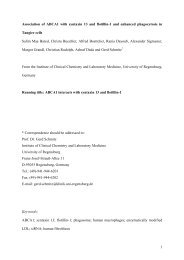SUNDAY, DECEMBER 4- Late Abstracts 1 - Molecular Biology of the ...
SUNDAY, DECEMBER 4- Late Abstracts 1 - Molecular Biology of the ...
SUNDAY, DECEMBER 4- Late Abstracts 1 - Molecular Biology of the ...
You also want an ePaper? Increase the reach of your titles
YUMPU automatically turns print PDFs into web optimized ePapers that Google loves.
<strong>SUNDAY</strong><br />
2035<br />
Inhibition <strong>of</strong> Notch1 signaling by APP intracellular domain.<br />
E-J. Ann 1 , J-H. Yoon 1 , J-S. Ahn 1 , H-S. Park 1 ; 1 Chonnam National University, Gwangju, Korea<br />
The Notch1 receptor is a crucial controller <strong>of</strong> cell fate decisions, and is also a key regulator <strong>of</strong><br />
cell growth and differentiation in a variety <strong>of</strong> contexts. In this study, we have demonstrated that<br />
<strong>the</strong> APP intracellular domain (AICD) attenuates Notch1 signaling by accelerated degradation <strong>of</strong><br />
<strong>the</strong> Notch1 intracellular domain (Notch1-IC) and RBP-Jk, through different degradation<br />
pathways. AICD suppresses Notch1 transcriptional activity by <strong>the</strong> dissociation <strong>of</strong> <strong>the</strong> Notch1-IC–<br />
RBP-Jk complex after processing by gamma-secretase. Notch1-IC is capable <strong>of</strong> forming a<br />
trimeric complex with Fbw7 and AICD, and AICD enhances <strong>the</strong> protein degradation <strong>of</strong> Notch1-<br />
IC through an Fbw7-dependent proteasomal pathway. AICD downregulates <strong>the</strong> levels <strong>of</strong> RBP-<br />
Jk protein through <strong>the</strong> lysosomal pathway. AICD-mediated degradation is involved in <strong>the</strong><br />
preferential degradation <strong>of</strong> non-phosphorylated RBP-Jk. Collectively, our results demonstrate<br />
that AICD functions as a negative regulator in Notch1 signaling through <strong>the</strong> promotion <strong>of</strong><br />
Notch1-IC and RBP-Jk protein degradation.<br />
2036<br />
Isoprenylcysteine methylation is required for growth and endocytosis in Dictyostelium<br />
discoideum.<br />
K. J. McQuade 1 , J. Bollan 1 , K. Bailey 1 , J. Fritz 1 ; 1 Colorado Mesa University, Grand Junction, CO<br />
Many members <strong>of</strong> <strong>the</strong> Ras superfamily <strong>of</strong> small monomeric GTPases and o<strong>the</strong>r membraneassociated<br />
proteins ending in carboxy-terminal –CAAX motifs are proteolytically processed and<br />
reversibly methylated on isoprenylated terminal cysteine residues. Methylation is thought to<br />
regulate localization and activity <strong>of</strong> <strong>the</strong>se proteins. Ras GTPases are <strong>of</strong>ten overactive in cancer<br />
cells and inhibitors <strong>of</strong> isoprenylcysteine methyltransferase are being tested as potential<br />
chemo<strong>the</strong>rapies, but <strong>the</strong> cellular effects <strong>of</strong> <strong>the</strong>se inhibitors are unclear. We are characterizing<br />
<strong>the</strong> effects <strong>of</strong> loss <strong>of</strong> isoprenylcysteine methyltransferase activity in <strong>the</strong> social amoeba,<br />
Dictyostelium discodeum. Amoebae lacking methyltransferase activity grow slowly on bacterial<br />
lawns and do not grow in shaking or adherent axenic culture. Methyltransferase-deficient cells<br />
also migrate slowly towards folate, have reduced rates <strong>of</strong> endocytosis and are sensitive to<br />
osmotic shock. The mechanisms underlying <strong>the</strong>se defects are being investigated.<br />
2037<br />
Understanding <strong>the</strong> cellular function <strong>of</strong> poly(ADP-ribose) and its importance in cancer.<br />
K. Krukenberg 1 , T. Mitchison 2 ; 1 Systems <strong>Biology</strong>, Harvard Medical School, Boston, MA,<br />
2 Systems <strong>Biology</strong>, Harvard Medical School<br />
Poly(ADP-ribose) is a unique but poorly understood post-translational modification. It has been<br />
implicated in multiple cellular processes including DNA damage, cell death, inflammation,<br />
protein stability and cell division. In <strong>the</strong> clinic, inhibition <strong>of</strong> poly(ADP-ribose) formation is showing<br />
promise as a cancer <strong>the</strong>rapeutic. Poly(ADP-ribose) polymerases (PARPs) catalyze <strong>the</strong> addition<br />
<strong>of</strong> ADP-ribose onto acceptor proteins using NAD+ as a substrate. Though <strong>the</strong> importance <strong>of</strong><br />
PARPs and poly(ADP-ribose) is clear, <strong>the</strong>ir biological functions are not well understood. We are<br />
working on developing tools for characterizing <strong>the</strong> function <strong>of</strong> PARPs and poly(ADP-ribose) and<br />
are using <strong>the</strong>se tools to fur<strong>the</strong>r identify and define <strong>the</strong> biological roles <strong>of</strong> <strong>the</strong>se intriguing and<br />
essential molecules. Here we describe an assay for quantifying <strong>the</strong> levels <strong>of</strong> poly(ADP-ribose) in<br />
cells that has increased sensitivity as compared to previous approaches. Using this assay, we<br />
quantified <strong>the</strong> extent to which poly(ADP-ribose) levels vary throughout <strong>the</strong> cell cycle. We have<br />
also found that different cancer cell types have different amounts <strong>of</strong> poly(ADP-ribose) and <strong>the</strong>se
















